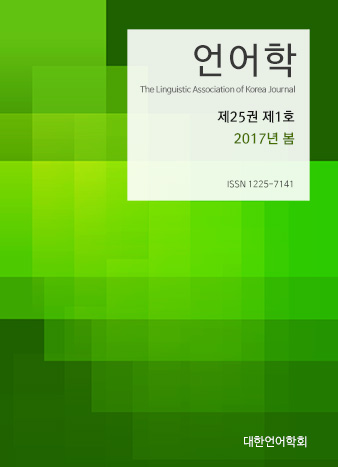대한언어학회 전자저널

-
Why is the Locative NP in Kiswahili not Syntactically Oblique?
-
Developmental Errors in Chinese L1 Speakers’ Use of the L2 English Past Tense and Perfective Aspect
-
An Exploration of High School Reading Test Items Based on Discriminant Analysis
-
Marketization of University Brochures in Korea and the US: From a Genre Analysis Perspective
25권 1호 (2017년 3월)
- 한국어 수사구의 언어유형론적 고찰
-
정해권
Pages : 183-202
Abstract
Keywords
# 주제어(Key Words): 언어유형론(linguistic typology) # 수(number) # 수사(number word) # 수열(number sequence) # 분류사(classifier) # 수사구(numeral phrase) # 기본수(number base)
References
- 고명균. (2007). 17세기 국어 수량 의존명사에 관한 연구. 남성우 외(편). 국어사 연구와 자료 (pp. 103-134). 서울: 태학사.
- 고영근·구본관. (2008). 우리말 문법론. 파주: 집문당.
- 구본관. (2001). 수사와 수관형사의 형태론. 형태론, 3(2), 265-284.
- 김방한. (1983). 한국어의 계통. 서울: 민음사.
- 김성규. (1984). 국어 수사체계의 일고찰. 관악어문연구, 4, 419-432.
- 김승곤. (1984). 한국어의 기원. 서울: 건국대학교 출판부.
- 민현식. (1998). 의존명사. 서태룡 외(편). 문법 연구와 자료 (pp. 165-198). 서울: 태학사.
- 박교식. (2008). 한국어 수사의 어원에 관한 수학사적 조망: 하나에서 열까지. 한국수학사학회지, 21(3), 97-112.
- 박정구. (2012). 유형론적 관점에서 본 중국어 분류사의 발전 및 그와 한국어의 관련성. 국어학, 63, 391-412.
- 박진호. (2015). 언어유형론이 한국어 문법 연구에 계시하는 것들. 일어일문학연구, 94(1), 3-27.
- 송기중. (2004). 역사비교언어학과 국어계통론. 서울: 집문당.
- 신용태. (1988). 원시 한일어의 연구. 서울: 동국대학교 출판부.
- 신용하. (2017). 한국민족의 기원과 형성 연구. 서울: 서울대학교출판문화원.
- 이등룡. (2001). 한국어의 친족어를 찾기 위한 연구-10의 수사 *on을 근거로-. 인문과학, 31, 49-64.
- 이승재. (2011). 미륵사지 목간에서 찾은 고대어 수사. 국어학, 62, 3-46.
- 이익섭. (1973). 국어 수량사구의 통사 기능에 대하여. 어학연구, 9(1), 46-63.
- 정제한. (1998). 단위명사. 서태룡 외(편). 문법 연구와 자료 (pp. 199-226). 서울: 태학사.
- 조규태. (2006). 한국어 수사의 어원과 어형 변화에 대하여. 어문학, 94, 81-117.
- 조미희. (2015). ‘번역노걸대’의 수량사구 구성 연구. 우리말연구, 42, 129-166.
- 채 완. (1982). 국어 수량사구의 통시적 고찰. 진단학보, 53, 155-170.
- 채 완. (1983). 국어 수사 및 수량사구의 유형적 고찰. 어학연구, 19(1), 19-34.
- 최학근. (1964). 국어 수사와 Altai어족 수사와의 어느 공통점에 대하여. 도남 조윤제 박사 회갑 기념 논문집 (pp. 569-599).
- Aikhenvald, A. Y. (2000). Classifiers: A typology of noun categorization devices: A typology of noun categorization devices. Oxford: Oxford University Press.
- Aston, W. G. (1879). A comparative study of the Japanese and Korean languages. Journal of the Royal Asiatic Society of Great Britain and Ireland (New Series), 11(3), 317-364.
- Comrie, B. (2005). Numeral bases. In M. Haspelmath (Ed.). The world atlas of language structures (pp. 530-533). Oxford: Oxford University Press.
- De Heinzelin, J. (1962). Ishango. Scientific American, 206, 105-116.
- Greenberg, J. H. (1975). Dynamic aspects of word order in the numeral classifier. In C. N. Li (Ed.). Word Order and Word Order Change (pp. 27-45). Austin: University of Texas Press.
- Greenberg, J. H. (1978). Generalizations about numeral systems. Universals of human language, 3, 249-295.
- Haarmann, H. (2008). Weltgeschichte der Zahlen. München: Verlag CH Beck. 전대호 역. (2013). 숫자의 문화사. 파주: 문학동네.
- Heine, B. (1997). Cognitive Foundations of Grammar. Oxford University Press. 이성하·구현정 역. (2004). 문법의 인지적 기초. 서울: 박이정.
- Henshilwood, C. S., d'Errico, F., Yates, R., Jacobs, Z., Tribolo, C., Duller, G. A., & Wintle, A. G. (2002). Emergence of modern human behavior: Middle Stone Age engravings from South Africa. Science, 295(5558), 1278-1280.
- Ifrah, G., Harding, E. F., Bellos, D., & Wood, S. (2000). The universal history of computing: From the abacus to quantum computing. New York: John Wiley.
- Jones, W. (1824). Discourses delivered before the Asiatic Society: and miscellaneous papers, on the religion, poetry, literature, etc., of the nations of India, London: CS Arnold.
- Lehmann, W. P. (2013). Historical linguistics: an introduction. London: Routledge.
- Menninger, K. (1992). Number Words and Number Symbols: A Cultural History of Numbers. New York : Dover Publications. 김량국 역. (2005). 수의 문화사. 서울: 열린책들.
- Miller, R. A. (1969). The Altaic numerals and Japanese. The Journal-News letter of the Association of Teachers of Japanese, 6(2), 14-29.
- Ramstedt, G. J. (1949), Studies in Korean Etymology. Helsingfors: Suomalais- Ugrilainen Seura.
- Ramstedt, G. J. (1952). Einführung in die altaische Sprachwissenschaft. II. Formenlehre. Bearbeitet und herausgegeben. Helsingfors: Suomalais-Ugrilainen Seura. 김동소 역. (1985). 알타이어 형태론 개설. 서울: 민음사.
- Schmidt, W. (1926). Die Sprachfamilien und Sprachenkreise der Erde : Atlas von 14 Karten. Heidelberg : Winter.
- Stampe, D. (1976). Cardinal number systems. In Papers from the Regional Meeting Chicago Linguistic Society, 12, 596-609.